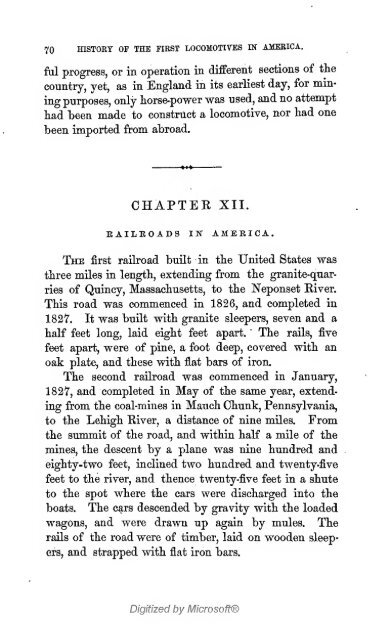The history of the first locomotives in America. From original ...
The history of the first locomotives in America. From original ...
The history of the first locomotives in America. From original ...
You also want an ePaper? Increase the reach of your titles
YUMPU automatically turns print PDFs into web optimized ePapers that Google loves.
70<br />
HISTORY OF THE FIRST LOCOMOTIVES IN AMERICA.<br />
ful progress, or <strong>in</strong> operation <strong>in</strong> different sections <strong>of</strong> <strong>the</strong><br />
country, yet, as <strong>in</strong> England <strong>in</strong> its earliest day, for m<strong>in</strong>-<br />
<strong>in</strong>g purposes, only horse-power was used, and no attempt<br />
had heen made to construct a locomotive, nor had one<br />
been imported from abroad.<br />
CHAPTEE XII.<br />
EAILEOADS IN AMERICA.<br />
<strong>The</strong> <strong>first</strong> railroad built <strong>in</strong> <strong>the</strong> United States was<br />
three miles <strong>in</strong> length, extend<strong>in</strong>g from <strong>the</strong> granite-quar-<br />
ries <strong>of</strong> Qu<strong>in</strong>cy, Massachusetts, to <strong>the</strong> Neponset Kiver.<br />
This road was commenced <strong>in</strong> 1826, and completed <strong>in</strong><br />
1827. It was buUt with granite sleepers, seven and a<br />
half feet long, laid eight feet apart. " <strong>The</strong> rails, five<br />
feet apart, were <strong>of</strong> p<strong>in</strong>e, a foot deep, covered with an<br />
oak plate, and <strong>the</strong>se with flat bars <strong>of</strong> iron.<br />
<strong>The</strong> second railroad was commenced <strong>in</strong> January,<br />
1827, and completed <strong>in</strong> May <strong>of</strong> <strong>the</strong> same year, extend-<br />
<strong>in</strong>g from <strong>the</strong> coal-m<strong>in</strong>es <strong>in</strong> Maiich Chunk, Pennsylvania,<br />
to <strong>the</strong> Lehigh River, a distance <strong>of</strong> n<strong>in</strong>e miles. <strong>From</strong><br />
<strong>the</strong> summit <strong>of</strong> <strong>the</strong> road, and with<strong>in</strong> half a mile <strong>of</strong> <strong>the</strong><br />
m<strong>in</strong>es, <strong>the</strong> descent by a plane was n<strong>in</strong>e hundred and<br />
eighty-two feet, <strong>in</strong>cl<strong>in</strong>ed two hundred and twenty-five<br />
feet to <strong>the</strong> river, and <strong>the</strong>nce twenty-five feet <strong>in</strong> a shute<br />
to <strong>the</strong> spot where <strong>the</strong> cars were discharged <strong>in</strong>to <strong>the</strong><br />
boats. <strong>The</strong> cars descended by gravity with <strong>the</strong> loaded<br />
wagons, and were drawn up aga<strong>in</strong> by mules. <strong>The</strong><br />
rails <strong>of</strong> <strong>the</strong> road were <strong>of</strong> timber, laid on wooden sleep-<br />
ers, and strapped with flat iron bars.<br />
Digitized by Micros<strong>of</strong>t®
















